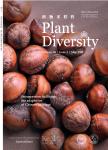Global patterns and ecological drivers of taxonomic and phylogenetic endemism in angiosperm genera
作者机构:Research and Collections CenterIllinois State Museum1011 East Ash StreetSpringfieldIL 62703USA University and Jepson HerbariaDepartment of Integrative BiologyUniversity of CaliforniaBerkeleyCA 94720-2465USA Center for Global Change and Complex EcosystemsZhejiang Tiantong Forest Ecosystem National Observation and Research StationSchool of Ecological and Environmental SciencesEast China Normal UniversityShanghai 200241China Shanghai Institute of Pollution Control and Ecological SecurityShanghai 200092China Key Laboratory of the Three Gorges Reservoir Region's Eco-EnvironmentMinistry of EducationChongqing UniversityChongqing 400045China
出 版 物:《Plant Diversity》 (植物多样性(英文版))
年 卷 期:2024年第46卷第2期
页 面:149-157页
核心收录:
学科分类:0710[理学-生物学] 071001[理学-植物学] 07[理学]
主 题:Angiosperm Current climate Endemism Historical climate change Topographic heterogeneity
摘 要:Endemism of lineages lies at the core of understanding variation in community composition among geographic regions because it reflects how speciation,extinction,and dispersal have influenced current distributions.Here,we investigated geographic patterns and ecological drivers of taxonomic and phylogenetic endemism of angiosperm genera across the world.We identify centers of paleo-endemism and neo-endemism of angiosperm genera,and show that they are mostly located in the Southern Hemisphere in tropical and subtropical regions,particularly in Asia and Australia.Different categories of phylogenetic endemism centers can be differentiated using current climate conditions.Current climate,historical climate change,and geographic variables together explained~80%of global variation in taxonomic and phylogenetic endemism,while 42-46%,1%,and 15%were independently explained by these three types of variables,respectively.Thus our findings show that past climate change,current climate,and geography act together in shaping endemism,which are consistent with the findings of previous studies that higher temperature and topographic heterogeneity promote endemism.Our study showed that many centers of phylogenetic endemism of angiosperms,including regions in Amazonia,Venezuela,and west-central tropical Africa that have not previously been identified as biodiversity hotspots,are missed by taxon-based measures of endemism,indicating the importance of including evolutionary history in biodiversity assessment.



